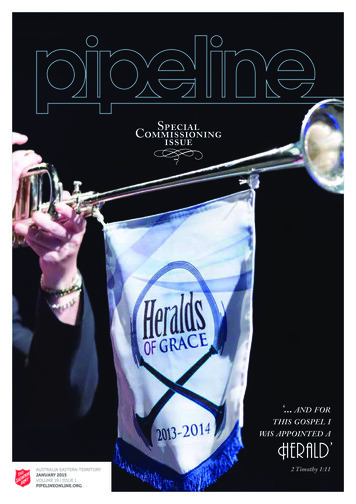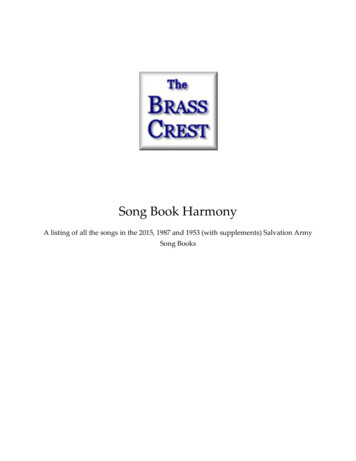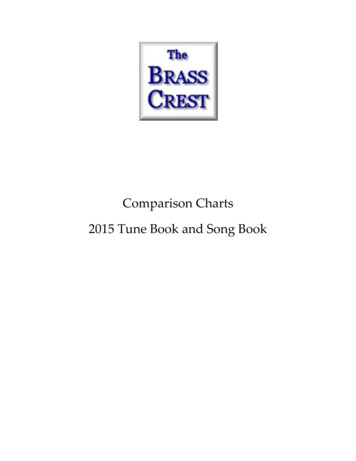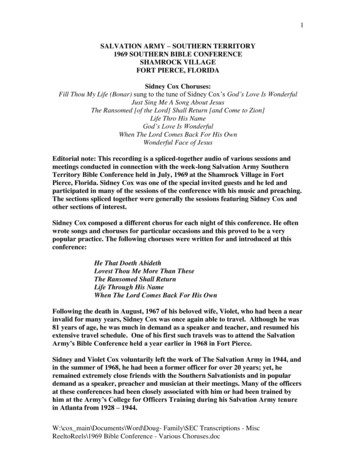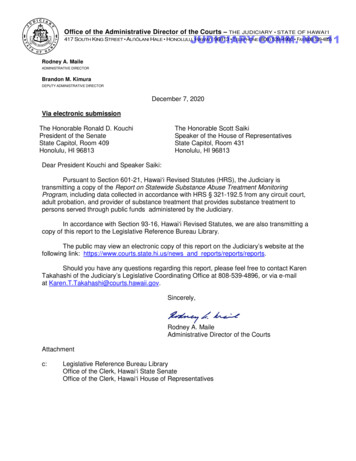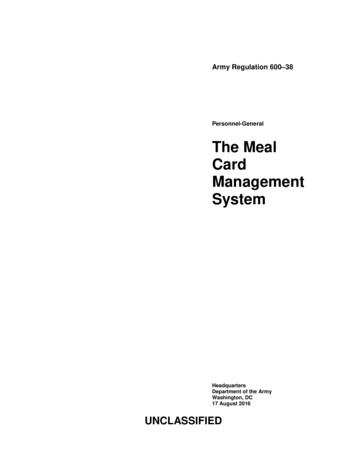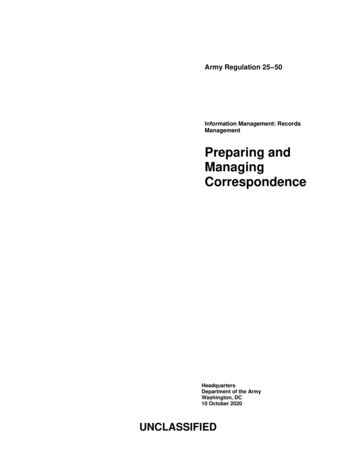
Transcription
THE SALVATION ARMYHANDBOOK OF DOCTRINE
THE SALVATION ARMYHANDBOOK OF DOCTRINESalvation BooksThe Salvation Army International HeadquartersLondon, United Kingdom
c 2010The General of The Salvation ArmyThis edition published 2010Publishing historyThe Doctrines and Disciplines of The Salvation Army published 1881Second edition 1883The Doctrines of The Salvation Army 1885Ten subsequent editions, eleventh edition 1913Handbook of Salvation Army Doctrine 1922Second edition 1925Third edition, retitled The Salvation Army Handbook of Doctrine 1927Fourth edition 1935Reprints or new impressions in 1940, 1955, 1960, 1961 and 1964New Handbook of Doctrine published 1969Reprinted several times, then revised and published as Salvation Story1998 with an accompanying Study Guide 1999The two books amalgamated and reissued in this edition asThe Salvation Army Handbook of Doctrine 2010ISBN 978-0-85412-822-8Unless stated otherwise, all scriptural quotations are taken from theNew International VersionPublished by Salvation BooksThe Salvation Army International Headquarters101 Queen Victoria Street, London EC4V 4EH, United KingdomPrinted by UK Territory Print & Design Unit
ContentsForewordThe Doctrines of The Salvation ArmyBefore you begin reading . . .Chapter 1: Word of the Living GodA. A word in time1. The Canon2. TestamentsB. Revelation1. God made known2. Modes of revelationC. Given by inspirationD. AuthorityE. Scripture and other authorities1. Scripture, Spirit and Church2. The primary authority3. PluralismF. A word for all timeForA.B.C.D.Pagexiiixvxvii11233345666789further exploration 1Essentials of the doctrineHistorical summaryInterpretation of ScriptureIssues for Salvationists1010131821Chapter 2: Creator of Heaven and EarthA. Christian monotheismB. The character of Godv252526
1. Perfect in holiness2. Perfect in wisdom3. Perfect in power4. Perfect in loveC. Creator of Heaven and Earth1. Creation out of nothing2. The problem of evilD. Preserver and Governor1. God’s continuing purpose2. Caring for God’s world3. The glory of GodE. The human response: worship1. Responding to God2. The danger of idolatryF. A God to make 404348further exploration 2Essentials of the doctrineCreation and scienceThe problem of sufferingIssues for SalvationistsChapter 3: The God who is never aloneA. A God in fellowshipB. God the FatherC. God the Son1. A God who makes himself known2. A God involved with us3. A God who savesD. God the Holy Spirit1. The Holy Spirit is the Spirit of Christ2. The Holy Spirit is Lord3. The Holy Spirit is free and powerful4. The Holy Spirit is the giver of lifeE. A God who is three and onevi51515254545455555656575758
ForA.B.C.D.E.F.further exploration 3Essentials of the doctrineHistorical summaryTrinitarian heresiesGod the FatherGod the Holy SpiritIssues for Salvationists59596067687075Chapter 4: God’s eternal SonA. Jesus the man1. A historical figure2. A real human being3. A unique human beingB. Jesus God’s Son1. The Incarnation2. The Virgin BirthC. Jesus Christ our LordD. Salvation through JesusE. Our salvation, our r exploration 4Essentials of the doctrineNames and titles of JesusHistorical summaryContemporary debateChristological debate and heresiesIssues for Salvationists8686879094102105Chapter 5: Distorted imageA. Creation and Fall: the biblical witnessB. Created in the image of GodC. Fallen humanityD. The origin of sinE. The nature of sin109110110111112112vii
G.1. Original sin2. DepravityThe consequence of sin1. Separation from God2. The wrath of GodSalvation through the grace of God113113114114115115ForA.B.C.further exploration 5Essentials of the doctrineHistorical summaryIssues for Salvationists117117118125F.Chapter 6: Atonement through ChristA. The means of Atonement1. The Atonement foreshadowed2. The Atonement completedB. Understanding the Atonement1. Ransom2. The law courts3. Redemptive sacrifice4. Victory over sin5. Self-giving loveC. Our crucified and risen LordD. Death and life for all believersE. Grace and free willF. A gospel to be 32ForA.B.C.134134135142further exploration 6Essentials of the doctrineHistorical summaryIssues for SalvationistsChapter 7: The process of salvationA. Repentance1. In the life and ministry of Jesus2. As a response to the work of Christviii145145145146
B. FaithC. RegenerationD. The work of the Holy Spirit1. The promise of the Spirit2. The Spirit in Jesus3. The work of the Spirit in the life of the believer4. The Spirit in the 160further exploration 7Essentials of the doctrineHistorical summaryLater theological developmentsIssues for SalvationistsChapter 8: The nature of salvationA. JustificationB. Justified by graceC. Justification through faith1. The nature of faith2. Faith and worksD. AssuranceE. A salvation to be claimed163163164165165166166167ForA.B.C.further exploration 8Essentials of the doctrineHistorical summaryIssues for Salvationists169169170176Chapter 9: Maintaining salvationA. The blessings of salvationB. BackslidingC. Continued obedient faith179179180181ix
ForA.B.C.further exploration 9Essentials of the doctrineHistorical summaryIssues for Salvationists183183184189Chapter 10: Full salvationA. The sanctifying Spirit at work1. Sanctification2. God’s gracious provision3. By grace through faith4. A radical life-change5. A lifelong processB. The life of holiness1. The restoration of the covenant2. Holiness and ethics3. Wholeness, health and healing4. A holiness to be lived out in C.D.199199202205219further exploration 10Essentials of the doctrineInterpretations of the holiness experienceHistorical summaryIssues for SalvationistsChapter 11: Kingdom of the risen LordA. The Christian hope1. The triumph of the Kingdom of God2. Eternal lifeB. Death and resurrection1. The immortality of the soul2. The resurrection of the bodyC. Ultimate accountability1. Judgment2. Hell and HeavenD. A hope to be sharedx223223224224225225226226227227228
ForA.B.C.D.further exploration 11Essentials of the doctrineHistorical summaryInterpretations of the return of ChristIssues for Salvationists229229231241243A Salvationist understanding of the ChurchA. The Body of ChristB. The people of GodC. The Church as community1. A community of reconciliation2. A continuing community3. A gathered community4. A scattered community5. A community renewed for the future247248248248248249250252253The Church: study notesA. Essential characteristicsB. Historical summaryC. The Salvation Army and the ChurchD. Spiritual giftsE. The SacramentsF. Issues for Salvationists255255259265268269272Appendices1. The Classical Creeds2. The Doctrines of the Methodist New Connexion (1838)3. The Lausanne Covenant4. The International Spiritual Life Commission Report5. The Salvation Army in the Body of Christ6. Salvation Army covenants7. How to use the Handbook of Doctrine8. A Salvation Army lectionary9. People and events from Church history277282284294310319323327334xi
Glossary of theological terms344Glossary of English usage349Index352All biblical quotations are from theNew International Version unless otherwise indicated.TNIVToday’s New International VersionKJV King James Versionxii
ForewordI welcome warmly this re-issued, single-volume edition of TheSalvation Army Handbook of Doctrine. We are indebted to theInternational Doctrine Council for most helpful work.The very first Doctrine Book, entitled The Doctrines andDiscipline of The Salvation Army, was prepared by General WilliamBooth for use at the ‘Training Homes’ in 1881. At first it was notmade available for wider use but, in response to comments thatcadets were being taught from ‘a secret book’, a public edition wenton sale in 1883. Various further editions, entitled The Doctrines ofThe Salvation Army, were published between 1885 and 1913 (whichsaw the 11th edition). Until 1892 these various editions were subtitled: ‘Prepared for Training Homes’. After 1900 this changed to:‘Prepared for the Use of Cadets in Training for Officership’, thoughwe should note that the use was not restricted exclusively to cadetsin training. They were used by officers generally for training andstudy purposes in corps settings.A new Handbook of Salvation Army Doctrine, prepared under thedirection of General Bramwell Booth, was published in 1922.Subsequent revised editions appeared in 1925, 1927 and 1935, withreprints or new impressions appearing in 1940, 1955, 1960, 1961and 1964.A new Handbook of Doctrine was published by General FrederickCoutts in 1969 and this was reprinted several times prior to anentirely re-modelled Handbook of Doctrine appearing in 1998 withthe title of Salvation Story. Salvation Story was swiftly followed bya related Study Guide in 1999.This 2010 Handbook of Doctrine retains the wording of the 1998edition except for minor clarifications and stylistic changes. Thexiii
principal aim has been to maximise user-friendliness, for exampleby reallocating the Bible references and inserting them into the mainnarrative at the relevant places; renumbering the chapters to matchthe numbers of the Doctrines; merging the main Handbook with the1999 Study Guide into a single volume, removing outdated materialfrom the latter and condensing some parts of it; revising certainAppendices and introducing three new study aids by way ofAppendices 5, 6 and 9.In his Foreword to Salvation Story, General Paul Rader wrote:‘What Salvationists believe has never been incidental to how welive out our life in Christ as individuals, or as a global spiritualmovement. Our faith, grounded in Scripture, and validatedvictoriously by personal experience, has been the motive force ofour obedience in mission.’ We can say a firm ‘Amen!’ to that,praying earnestly to God for the ongoing usefulness of this latestHandbook in reinforcing our faith and undergirding our creed asSalvationists.Shaw CliftonGeneralInternational Headquarters, London, EnglandMarch 2010xiv
The Doctrines ofThe Salvation Army1. We believe that the Scriptures of the Old and New Testamentswere given by inspiration of God, and that they only constitutethe Divine rule of Christian faith and practice.2. We believe that there is only one God, who is infinitely perfect,the Creator, Preserver, and Governor of all things, and who isthe only proper object of religious worship.3. We believe that there are three persons in the Godhead – theFather, the Son and the Holy Ghost, undivided in essence andco-equal in power and glory.4. We believe that in the person of Jesus Christ the Divine andhuman natures are united, so that he is truly and properly Godand truly and properly man.5. We believe that our first parents were created in a state ofinnocency, but by their disobedience they lost their purity andhappiness, and that in consequence of their fall all men havebecome sinners, totally depraved, and as such are justlyexposed to the wrath of God.6. We believe that the Lord Jesus Christ has by his suffering anddeath made an atonement for the whole world so thatwhosoever will may be saved.xv
7. We believe that repentance towards God, faith in our Lord JesusChrist, and regeneration by the Holy Spirit, are necessary tosalvation.8. We believe that we are justified by grace through faith in ourLord Jesus Christ and that he that believeth hath the witness inhimself.9. We believe that continuance in a state of salvation dependsupon continued obedient faith in Christ.10. We believe that it is the privilege of all believers to be whollysanctified, and that their whole spirit and soul and body may bepreserved blameless unto the coming of our Lord Jesus Christ.11. We believe in the immortality of the soul; in the resurrection ofthe body; in the general judgment at the end of the world; in theeternal happiness of the righteous; and in the endlesspunishment of the wicked.xvi
Before you begin reading For Salvationists, belief and action have always been intertwined.Our faith and practice are rooted in the Bible, personal experienceand the Christian heritage. Salvation Army doctrine is part of thatheritage, and it too is built upon the foundation of the biblical textas interpreted by the people of God.This book is about Salvation Army doctrine. It explores the 11Articles of Faith which since 1878 have been the basis of TheSalvation Army’s witness to the Christian gospel, showing howthey are rooted in the Bible and in the tradition of the Church. Italso provides opportunities to consider how they are intimatelyrelated to the personal faith of every Salvationist and the witnessand fellowship of the Salvationist community.Some people may wonder why Salvationists place suchemphasis upon a written statement of faith. At the heart ofChristianity is the believer’s relationship with Jesus Christ, whichis deeply personal and may often elude definition. Yet it is alsoinescapably communal and will flourish best in fellowship withother believers. Through the centuries the Church has learned toexpress the common experience of faith, in ways that areconsistent with the biblical witness, in creeds and statements offaith.The earliest Christians acknowledged one another in the simpleconfession: ‘Jesus is Lord’ (1 Corinthians 12:3). This was theircreed. As they shared it, they grounded their personal experiencein the risen Christ, verified one another’s experience and calledupon the world to acknowledge the Lordship of Christ. It was fromthese biblical beginnings that the creeds of the Church grew to beauthoritative statements of the Christian faith. Three creeds datingxvii
from the early centuries of Christian faith, the Apostles’ Creed, theNicene Creed and the Athanasian Creed, have become known asthe classical creeds (Appendix 1). In due course further credalstatements, which often identify the doctrinal emphases ofparticular church groupings, have come into being. Examples ofthese are the Westminster Confession, which is still regarded asdefinitive in Presbyterian Churches, and the Augustana, whichfrom the time of the Reformation has marked the distinctive tenetsof Lutheranism.Our Salvation Army Articles of Faith fulfil a similar function.While their origin is nowhere stated, their roots are clearly in theWesleyan tradition. The articles bear a striking similarity in wordsand content to Methodist New Connexion doctrines, which can betraced back to 1838 (Appendix 2). William Booth was an ordainedminister of the New Connexion, whose founders claimed theirdoctrines to be ‘those of Methodism, as taught by Mr Wesley’. In1865 William Booth adopted seven articles of belief for the fledglingChristian Mission. Three more were added in 1870 and the last,now number nine, in 1876. Each additional point can be tracedback to the New Connexion document. With only slight editorialmodifications, chiefly in punctuation, these Articles are placed asSchedule 1 of The Salvation Army Act, 1980.Our doctrinal statement, then, derives from the teaching of JohnWesley and the evangelical awakening of the 18th and 19thcenturies. While there was significant correspondence betweenevangelicals in the mid-19th century, indicated especially in thenine-point statement of the Evangelical Alliance of 1846, thedistinctives of Salvation Army doctrine came from Methodism. Ourstrong emphasis on regeneration and sanctification, our convictionthat the gospel is for the whosoever and our concern for humanity’sfree will all find their roots there.Doctrine is therefore the teaching of the Church. It is anexpanded explanation of faith, founded on Scripture and developedfrom the creeds. The Salvation Army’s 11 Articles of Faith(Doctrines) are an expression both of personal faith and a commonxviii
vision. They are consistent with the classical Christian creeds andidentify Salvationists as members of the body of Christ on earth.The 11 doctrines of The Salvation Army are often taught anddiscussed as separate statements of faith. Rather than thinking aboutthem one at a time, it is possible to see the genius in the doctrinesby viewing them and reflecting on them in a way that identifies apattern. The pattern is distinctively reflective of the Wesleyantheology that is at the heart of Salvationist doctrinal thinking.Doctrines 1-4 are about God, who is the inspirer of Scripture,which provides the basis for our faith and practice; he is Creator,Governor and Preserver; and is Father, Son, and Holy Spirit, thenature or essence of the Trinity as revealed in Scripture; and is theRedeemer who is both human and divine. Doctrine 5 describes thefallen nature of humanity and its consequences, which can beredeemed only by God’s gift of Jesus and his sacrifice upon theCross (Doctrine 6). Doctrines 6, 7, 8, 9, 10 and 11 together conveythe dynamic interaction of God’s grace, our response and God’saction in our lives as we trust in him. They explore a dynamic andinteractive relationship that reflects the prevenient, justifying,sanctifying and glorifying grace of God. In other words they togetherreflect the via salutis (the way of salvation), the continuum of God’sgrace, the journey with Christ by those who come to faith in him.Doctrines 9 and 10 are inextricably linked, as continuance in a stateof salvation leads to holiness and Christlikeness. As we consecrateourselves (Doctrine 9), God sanctifies us (Doctrine 10). Finally,Doctrine 11 reminds us of ultimate salvation and of theconsequences of our choices in this life.The doctrines explore and define our understanding of God,humanity and the developing relationship of the Christian life, andare best understood when this pattern is kept in mind. They areunique to The Salvation Army, yet they share a common emphasiswith other Christian traditions. They are the foundation of faith,providing a benchmark which helps us to interpret and judgeexperience in order that we might best live our faith in our owncontext.xix
NoteEach chapter is presented in two sections. The first part of eachchapter contains the formal and officially approved Salvation Armyexegesis of the relevant article of faith. These together constitute theofficial Handbook of Doctrine.The second part of each chapter is entitled ‘For furtherexploration’. These sections are intended to be a useful resource,but do not form part of the official statement of Salvation Armydoctrine. There are also suggestions for reflection, discussion or anactivity. These are designed to encourage and enable you to relateyour knowledge of doctrinal issues to your personal spiritualexperience, your life in the Christian community and yourinteraction with the world.xx
Chapter 1Word of the Living GodThe source of Christian doctrineWe believe that the Scriptures of the Old and New Testamentswere given by inspiration of God, and that they only constitutethe Divine rule of Christian faith and practice.The first article of faith identifies the Bible as the source of bothChristian faith and Christian practice. Our faith therefore finds itsdefinition and defence in Scripture. The history of doctrinedemonstrates the ways in which the Church has understood,interpreted and communicated biblical truth. The first article is apreliminary statement that establishes the Bible as the sourcebookfor Christian doctrine.The Bible is a book written by many writers: it is a humandocument. But we believe that it is also God’s word(1 Thessalonians 2:13). It carries God’s authority, is the revealer oftruth and the guide for Christian living (2 Timothy 3:16, 17). In itspages we encounter the living God of history and from its teachingswe learn to live in relationship with him.A. A word in timeGod’s word has been given to us in the recorded experiences of menand women of faith over many centuries. The Bible explores theliving relationship between God and his people in particularhistorical contexts.1
1. The CanonThe Canon is that body of literature accepted by the Church as HolyScripture, the revealed word of God. It is comprised of both the Oldand New Testaments, and was probably first used to refer to theauthoritative body of Scripture by the theologian Origen ofAlexandria (c185-c254 AD). The word ‘Canon’ is the Englishequivalent of the Greek kanon and Hebrew kaneh, which means‘reed’. As a reed was sometimes used as a measuring rod, the wordcame to be used in that sense, and was eventually extended to referto all kinds of rulers or means of measurement, even to rules,standards or models. Thus the Scriptures were the ‘ruler’ by whichfaith and practice were to be measured.The first Christians accepted the Jewish sacred writings, nowknown as the Old Testament, as authoritative and appealed to theircontent to support the claims they were making for the divinemission and authority of Jesus. At the same time, they began tocommunicate the gospel message by the written as well as thespoken word. From very early in the Church’s history, certain ofthese writings were recognised as possessing authority; theseeventually became our New Testament.The Old Testament originated in the experience of the Jewishpeople over many centuries. It records the developing, but stillincomplete, revelation of God prior to the coming of his Son, JesusChrist. Christians have always loved and respected the OldTestament while recognising that the true interpretation of itsmeaning and the fulfilment of its promise are found only in Jesus.Without the New, the Old Testament remains incomplete.Conversely, the New Testament is incomplete without the Old. Whatthe New Testament announces is the fulfilment, in Jesus Christ, ofthe yearnings and hopes of the Old Testament.The New Testament is the written testimony to the life, teachingand person of Jesus Christ. Its books were written to instructbelievers and bring others to faith in him. When the Canon wasestablished in the fourth century, most of the books in our NewTestament were universally acknowledged by the Christian2
community. Those about which some reservation was expressedwere included or excluded on the basis of three guidelines: authenticbooks were to be of apostolic origin, conform to the accepted ruleof faith, and be commonly used by the churches.By this careful process, guided by the Holy Spirit, Christiansreached a consensus about the books regarded as Scripture. Theauthority of Scripture was not given by the Church; it wasrecognised and affirmed.2. TestamentsThe 66 books which comprise the Bible are divided into Old andNew Testaments, diverse writings united by a common theme.Testament means covenant. The Jewish Scriptures witness to thecovenant established by God with Israel (Exodus 34:10-28). TheNew Testament testifies to the new covenant, promised in the OldTestament (Jeremiah 31:31-34), established through Jesus Christ(Luke 22:20), and effective for all who trust in him.These books, differing widely in literary form and culturalbackground, may be studied as individual expressions of historiccultures. Christians, however, regard them as one book – the Bible.There is one theme, the saving grace of God, demonstrated throughGod’s dealings with his people, culminating in the saving work ofGod in Christ (Luke 24:25-27; 44-48; John 20:30, 31). There are twotestaments and one revelation. Thus these writings stand alone asa unique witness and possess unique authority deriving from theircontent, theme and divine origin.B. Revelation1. God made knownAll generations have witnessed to an awareness of divine presence,or to a conviction that the beauty and order of the universe suggestan almighty Creator (Romans 1:20). But God must always remainessentially a mystery to his creation and unaided we can make littleprogress in any quest to discover the saving truth about him. Since3
our perceptions have been affected by sin, our understanding of Godis clouded and distorted (Romans1:21-32).We believe that God, through his actions, has made known to uswhat we could never discover for ourselves – his loving character(Jeremiah 31:3), saving power (Psalm 68:19, 20) and eternalpurpose (Isaiah 55:8-11; John 3:16). He has ‘removed the veil’ thatshrouded his mystery. This self-revelation of God is faithfullypreserved and presented in the living record of holy Scripture.Revelation is a gift of grace, arising from God’s love for humanityand the divine intention that we should come to know, love, serveand enjoy God for ever. The Bible is the record and writtenexpression of that revelation. The insights of non-Christian religionsmay indicate spiritual awareness and understanding, but they donot present Jesus Christ as the Word made flesh (John 1:14-18).The term revelation means to ‘remove the veil’. In the Bible,revelation is seen to grow from the lesser to the greater and from thepartial to the perfect. The self-revealing of God recorded in the OldTestament is gradual and necessarily partial, since it prepared theway for the coming of Christ, God’s full and final revelation.2. Modes of revelationHuman beings encounter God in many ways in the pages ofScripture. Through the events of their early history, the Jews weregiven a sense of the steadfast love of God (Isaiah 63:7-14; Hosea11:1-4). They recognised his hand in their formation as a people,and in their ongoing history. God gave the Law to provide a patternfor living in his company (Deuteronomy 31:9-13; Psalm 119:105) andrevealed the intensity and purity of his love through the prophets(Amos 5:21-24; Hosea 14:4). In the Old Testament, history, law,prophecy and other writings contribute to a deepeningunderstanding of God’s majesty, holiness and love.All of these various modes of revelation find their focus in JesusChrist. God, active in history, acts uniquely in Jesus to bring hissalvation (Hebrews 1:1-3). The one of whom the prophets spoke isalso the fulfilment of the Law (Isaiah 53:1-6; Matthew 5:17-20). The4
New Testament describes Jesus’ personal history and proclaims thegospel message which the Church has preached ever since. So theBible offers what no other book can offer in the same way – theword of Life. It is a saving revelation centred upon Jesus Christ,God’s living Word (John 1:1-18).C. Given by inspiration‘All Scripture is God-breathed and is useful for teaching,rebuking, correcting and training in righteousness, so that allGod’s people may be thoroughly equipped for every good work.’(2 Timothy 3:16, 17 TNIV).The Bible is a gift of God, not a human achievement. It resultsfrom the interaction of divine power and human response, God’senabling initiative and the free obedience of human agents. Revealedtruth is communicated and preserved in written human language.The terms ‘divinely inspired’ or ‘given by inspiration of God’describe the ways in which the writers of the Bible, who often usedmany different literary sources, were so enlightened and directed bythe Holy Spirit that they produced a trustworthy and enduringwitness to God’s saving work for humanity, centred upon the lifeand person of Jesus Christ (John 20:30, 31; 2 Peter 1:20, 21).The writers enjoyed something more than the natural inspirationof an artist or author. At the same time, most Christians recognisethat inspiration is not dictation, and there is nothing in Scripture toindicate that God obliterated the human personalities of the authorsand turned them into copyists. Their individual styles of writing,habits of thinking, cultural background and human limitations canbe seen in the biblical text.However, the Bible cannot be explained only in human terms.The writings express not only human understanding, but also thework and word of God. An investigation into the message andclaims of the Bible shows them to exceed conventional humanwisdom, logic and goodness.5
D. AuthorityThe Bible is given by inspiration and contains the saving revelationof God, therefore the authority of Scripture overshadows all otherauthority. The Jewish people accepted the authority of their sacredwritings. Jesus concurred (Matthew 22:29-32; John 10:35b).Following the example of its Lord, the Early Church, from itsinception, recognised and appealed to the Jewish Canon and saw init the foundations of the gospel (Acts 2:16-21; 13:32-52; 28:25-27).However, it also came very quickly to recognise the inspiration andauthority of writings which together came to form the NewTestament. These writings are also foundational because throughtheir message we encounter Jesus Christ as Lord and Saviour.The Church did not give authority, but recognised it in thewritten word, accepting the authority of the Bible as the ultimatedeciding factor on issues of true Christian belief and discipleship,and placing itself in submission to it.History provides many examples of the Church searching theScriptures for guidance when dealing with crises and heresies. Italso records numerous occasions when the Christian communityhas been recalled to faith and discipleship by the Spirit through thebiblical message. The content of Scripture has provided a standardfor Christian life for both individuals and the whole people of God.For countless people, the Bible has proved its value as the reliableguidebook of both Christian faith and practice (2 Timothy 3:16, 17;2 Peter 1:19-21).E. Scripture and other authorities1. Scripture, Spirit and ChurchThe Bible, then, is the major authority for the Christian. However,the Bible itself teaches that there are three pillars which provide asecure foundation for Christian faith and practice. These three are:the teaching of Scripture (2 Timothy 3:16, 17), the directillumination of the Holy Spirit (Acts 8:29; 9:10-19; 13:1-3; 16:6-8)6
and the consensus of the Christian community (Acts 15:1-29; 1Thessalonians 5:12-22). The Bible is not safely read withoutreference to the general understanding of the Christian communitythroughout history, any more than it is understood wit
The very first Doctrine Book, entitled The Doctrines and Discipline of The Salvation Army, was prepared by General William Booth for use at the ‘Training Homes’ in 1881. At first it was not made available for wider use but, in response to comments that cadets were being taught from ‘a secr
